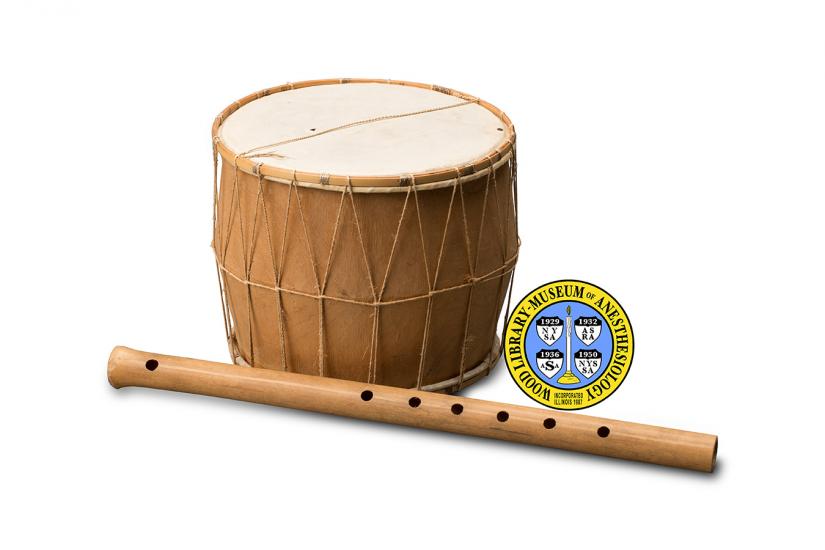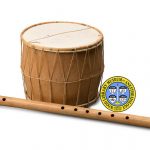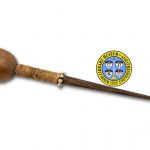Gill Musical Instruments
These musical instruments were collected by Richard C. Gill (1901-1958) during his time in Ecuador, around 1929 to 1938. The flute, drum and rattle are examples of instruments used by Native Americans of the Western Amazon for ceremonies, rituals and entertainment.
Gill was an adventurer and amateur ethnologist who, with his wife, built a plantation east of Baños de Agua Santa, Ecuador in 1929. In addition to growing fruits and vegetables, Gill conducted personal studies of the native peoples who lived in the Amazonian forests along the edges of his land. His studies included their social practices, music, and use of botanicals for medicine. He slowly earned the trust of many of the Indians he interacted with and even developed relationships with leaders of local villages.
Later, in 1938, these relationships, and Gill's cultural knowledge, enabled him to collect a large amount of curare, which was used by the Squibb Company to produce the first commercially available muscle relaxant, Intocostrin.
In 1942, Canadian anesthetists Harold R. Griffith and G. Enid Johnson were the first to report on the use of Intocostrin in anesthesia. Muscle relaxants keep automatic reflexes from interfering with invasive medical and surgical procedures. Their commercial introduction was followed by profound advancements in anesthesia and surgery.
Catalog Record: Gill Musical Instruments Three Catalog Records: alel, alem, and alen
Access Key: alel
Accession No.: 2013-07-15-1 B
Title: [Drum for curare preparation ceremony.]
Title variation: Alt Title
Title: Gill Collection drum.
Title variation: Alt Title
Title: Drum for curare-making ceremony.
Publisher: [Ecuador?] : [Ecuadorian Amazon native?], [between 1920 and 1938?].
Physical Descript: 1 musical instrument : wood, leather (monkey skin?), twine ; 17 cm in height and 21.5 cm in diameter.
Subject: Curare – history.
Subject: Muscle Relaxants – history.
Note Type: General
Notes: The title is based on the WLM common name for the object.
Note Type: General
Notes: The date range for the possible year of production is based around the time
when Richard Gill and his wife were in South America. The early year 1920 is
before the Gills when to South America, but was chosen in recognition that
the instrument may have been made some time before they traded for it. The
date range could change if documentation that indicates the dates should be
corrected is discovered.
Note Type: Citation
Notes: Gill RC. White Water and Black Magic. New York: Henry Holt and Company; 1940.
Note Type: Citation
Notes: Humble RM. The Gill-Merrill Expedition: penultimate chapter in the curare
story. Anesthesiology. 1982;57(6):519-526. https://journals.lww.
com/anesthesiology/toc/1982/12000. Accessed October 5, 2014.
Note Type: Citation
Notes: Larson M. Richard C. Gill and the introduction of curare into anesthesia
practice. CSA Bull. 2003;52(3):47-51. https://www.csahq.
org/pdf/bulletin/issue_2/guedel1.pdf. Accessed October 5, 2014.
Note Type: Citation
Notes: Olson DA. Symbol and function in South American Indian music. In: May E, ed.
Musics of Many Cultures: An Introduction. Berkeley: University of California
Press; 1980: 363-385.
Note Type: Citation
Notes: Schechter JM. Ecuador. In: Olsen DA, Sheehy DE, eds. South America, Mexico,
Central America, and the Caribbean. New York: Garland Publishing; 1998:414.
The Garland Encyclopedia of World Music; vol 2.
Note Type: Citation
Notes: Stirling MW. Historical and ethnographic material on the Jivaro Indians.
Smithonian Institution Bureau of American Ethnology. Bulletin 117. Washington
DC: Government Printing Office; 1938:92-94. https://babel.hathitrust.
org/cgi/pt?id=mdp.39015009138176;view=1up;seq=112. Accessed October 5, 2014.
Note Type: Citation
Notes: Wistrand LM. Music and song texts of Amazonian Indians. Ethnomusicology.
September, 1969;13(3):469-488.
Note Type: Physical Description
Notes: One double-headed drum measuring approximately 16.6 cm in height and 21.4 cm
in diameter; The conical body of the drum appears to have been carved from a
single tree stump or large branch; The top and bottom [heads] are covered
with a tight thin leather (possibly monkey skin); There is a small hole in
the top head of the drum; The heads are held in place by bamboo rings; The
rings are held down by thin twine, which is widely weaved to the top and
bottom rings; There are no maker marks.
Note Type: Reproduction
Notes: Photographed with a flute (2013-07-15-1 C) by Mr. Steve Donisch, February 10,
2014.
Note Type: Historical
Notes: This is one of the many musical instruments collected by Richard C. Gill
(1901-1958) during his time in Ecuador, around 1929 to 1938. It serves as one
example of the instruments used by Native Americans of the Western Amazon for
ceremonies, rituals and entertainment.
Gill was an adventurer and amateur ethnologist who, with his wife, built a
plantation east of Baños de Agua Santa, Ecuador in 1929. In addition to
growing fruits and vegetables, Gill conducted personal studies of the native
peoples who lived in the Amazonian forests along the edges of his land. His
studies included their social practices, music, and use of botanicals for
medicine. He slowly earned the trust of many of the Indians he interacted
with and even developed relationships with leaders of local villages. Later,
in 1938, these relationships, and Gill’s cultural knowledge, enabled him to
collect a large amount of curare, which was used by the Squibb Company to
produce the first commercially available muscle relaxant, intocostrin.
In 1942, Canadian anesthetists Harold R. Griffith, MD (1894-1985) and G. Enid
Johnson, MD (1909-2001) were the first to report on the use of intocostrin in
anesthesia. Muscle relaxants keep automatic reflexes from hampering invasive
medical and surgical procedures. Their commercial introduction was followed
by profound advancements in anesthesia and surgery.
Note Type: Publication
Notes: Betcher AM. The civilizing of curare: a history of its development and
introduction into anesthesiology. Anesth Analg. 1977;56(2):305-319.
https://journals.lww.com/anesthesia-analgesia/toc/1977/03000. Accessed October
5, 2014.
Note Type: Publication
Notes: Brown MF. Upriver: The Turbulent Life and Times of an Amazonian People.
Cambridge, Massachusetts: Harvard University Press, 2014.
Note Type: Publication
Notes: Izikowitz KG. Musical and other sound instruments of the South American
Indians. Ljunggren F, trans. East Ardsley: S.R. Publishers; 1970.
Note Type: Publication
Notes: Karsten R. The head-hunters of western Amazonas. Helsinki: Societas
Scientariarum Fennica; 1935 135, 137, 200, 323, 325, 415, 467, 496-502.
Commentationes humanarum litterarum; vol 7.
Note Type: Publication
Notes: List G. Music in the culture of the Jivaro Indians of the Ecuadorian Montaña,
Inter-American Music Bulletin. 1965;(40/41):1-17.
Note Type: Exhibition
Notes: Selected for the WLM website.
Access Key: alem
Accession No.: 2013-07-15-1 C
Title: [Flute for curare preparation ceremony.]
Title variation: Alt Title
Title: Gill Collection flute.
Title variation: Alt Title
Title: Flute for curare-making ceremony.
Publisher: [Ecuador?] : [Ecuadorian Amazon native?], [between 1920 and 1938?].
Physical Descript: 1 musical instrument : wood ; 3 x 3 x 11.5 cm.
Subject: Curare – history.
Subject: Muscle Relaxants – history.
Note Type: General
Notes: The title is based on the WLM common name for the object.
Note Type: General
Notes: The date range for the possible year of production is based around the time
when Richard Gill and his wife were in South America. The early year 1920 is
before the Gills when to South America, but was chosen in recognition that
the instrument may have been made some time before they traded for it. The
date range could change if documentation that indicates the dates should be
corrected is discovered.
Note Type: Citation
Notes: Gill RC. White Water and Black Magic. New York: Henry Holt and Company; 1940.
Note Type: Citation
Notes: Humble RM. The Gill-Merrill Expedition: penultimate chapter in the curare
story. Anesthesiology. 1982;57(6):519-526. https://journals.lww.
com/anesthesiology/toc/1982/12000. Accessed October 5, 2014.
Note Type: Citation
Notes: Larson M. Richard C. Gill and the introduction of curare into anesthesia
practice. CSA Bull. 2003;52(3):47-51. https://www.csahq.
org/pdf/bulletin/issue_2/guedel1.pdf. Accessed October 5, 2014.
Note Type: Citation
Notes: Olson DA. Symbol and function in South American Indian music. In: May E, ed.
Musics of Many Cultures: An Introduction. Berkeley: University of California
Press; 1980.
Note Type: Citation
Notes: Schechter JM. Ecuador. In: Olsen DA, Sheehy DE, eds. South America, Mexico,
Central America, and the Caribbean. New York: Garland Publishing; 1998:414.
The Garland Encyclopedia of World Music; vol 2.
Note Type: Citation
Notes: Stirling MW. Historical and ethnographic material on the Jivaro Indians.
Smithonian Institution Bureau of American Ethnology. Bulletin 117. Washington
DC: Government Printing Office; 1938:92-94. https://babel.hathitrust.
org/cgi/pt?id=mdp.39015009138176;view=1up;seq=112. Accessed October 5, 2014.
Note Type: Citation
Notes: Wistrand LM. Music and song texts of Amazonian Indians. Ethnomusicology.
September, 1969;13(3):469-488.
Note Type: Physical Description
Notes: One simple flute made of wood, possibly from a single node of a bamboo or
sugar cane; The measurements and description are based on the perspective
where the open end of the flute is the “front”; It measures approximately 2.8
x 3 x 11.3 cm (height x width x depth); It is open at one end and naturally
closed at the other end by a sheath scar; Six note holes begin approximately
6.6 cm from the open end of the recorder; Near the closed end is one venting
hole; There are no maker marks on the flute.
Note Type: Reproduction
Notes: Photographed with a drum (2013-07-15-1 B) by Mr. Steve Donisch, February 10,
2014.
Note Type: Historical
Notes: This is one of the many musical instruments collected by Richard C. Gill
(1901-1958) during his time in Ecuador, around 1929 to 1938. It serves as one
example of the instruments used by Native Americans of the Western Amazon for
ceremonies, rituals and entertainment.
Gill was an adventurer and amateur ethnologist who, with his wife, built a
plantation east of Baños de Agua Santa, Ecuador in 1929. In addition to
growing fruits and vegetables, Gill conducted personal studies of the native
peoples who lived in the Amazonian forests along the edges of his land. His
studies included their social practices, music, and use of botanicals for
medicine. He slowly earned the trust of many of the Indians he interacted
with and even developed relationships with leaders of local villages. Later,
in 1938, these relationships, and Gill’s cultural knowledge, enabled him to
collect a large amount of curare, which was used by the Squibb Company to
produce the first commercially available muscle relaxant, intocostrin.
In 1942, Canadian anesthetists Harold R. Griffith, MD (1894-1985) and G. Enid
Johnson, MD (1909-2001) were the first to report on the use of intocostrin in
anesthesia. Muscle relaxants keep automatic reflexes from hampering invasive
medical and surgical procedures. Their commercial introduction was followed
by profound advancements in anesthesia and surgery.
Note Type: Publication
Notes: Betcher AM. The civilizing of curare: a history of its development and
introduction into anesthesiology. Anesth Analg. 1977;56(2):305-319.
https://journals.lww.com/anesthesia-analgesia/toc/1977/03000. Accessed October
5, 2014.
Note Type: Publication
Notes: Brown MF. Upriver: The Turbulent Life and Times of an Amazonian People.
Cambridge, Massachusetts: Harvard University Press, 2014.
Note Type: Publication
Notes: Izikowitz KG. Musical and other sound instruments of the South American
Indians. Ljunggren F, trans. East Ardsley: S.R. Publishers; 1970.
Note Type: Publication
Notes: Karsten R. The head-hunters of western Amazonas. Helsinki: Societas
Scientariarum Fennica; 1935 135, 137, 200, 323, 325, 415, 467, 496-502.
Commentationes humanarum litterarum; vol 7.
Note Type: Publication
Notes: List G. Music in the culture of the Jivaro Indians of the Ecuadorian Montaña,
Inter-American Music Bulletin. 1965;(40/41):1-17.
Note Type: Exhibition
Notes: Selected for the WLM website.
Access Key: alen
Accession No.: 2013-07-15-1 A
Title: [Rattle].
Title variation: Alt Title
Title: Gourd rattle.
Title variation: Alt Title
Title: Calabash rattle.
Publisher: [Ecuador?] : [Ecuadorian Amazon native?], [between 1920 and 1938?].
Physical Descript: 1 musical instrument : gourd, wood, twine, seeds ; 41.5 cm in height and 8 cm in diameter.
Subject: Curare – history.
Note Type: General
Notes: Cataloger constructed title.
Note Type: General
Notes: The date range for the possible year of production is based around the time
when Richard Gill and his wife were in South America. The early year 1920 is
before the Gills when to South America, but was chosen in recognition that
the instrument may have been made some time before they traded for it. The
date range could change if documentation that indicates the dates should be
corrected is discovered.
Note Type: Citation
Notes: Gill RC. White Water and Black Magic. New York: Henry Holt and Company; 1940.
Note Type: Citation
Notes: Humble RM. The Gill-Merrill Expedition: penultimate chapter in the curare
story. Anesthesiology. 1982;57(6):519-526. https://journals.lww.
com/anesthesiology/toc/1982/12000. Accessed October 5, 2014.
Note Type: Citation
Notes: Larson M. Richard C. Gill and the introduction of curare into anesthesia
practice. CSA Bull. 2003;52(3):47-51. https://www.csahq.
org/pdf/bulletin/issue_2/guedel1.pdf. Accessed October 5, 2014.
Note Type: Citation
Notes: Olson DA. Symbol and function in South American Indian music. In: May E, ed.
Musics of Many Cultures: An Introduction. Berkeley: University of California
Press; 1980.
Note Type: Citation
Notes: Schechter JM. Ecuador. In: Olsen DA, Sheehy DE, eds. South America, Mexico,
Central America, and the Caribbean. New York: Garland Publishing; 1998:414.
The Garland Encyclopedia of World Music; vol 2.
Note Type: Citation
Notes: Stirling MW. Historical and ethnographic material on the Jivaro Indians.
Smithonian Institution Bureau of American Ethnology. Bulletin 117. Washington
DC: Government Printing Office; 1938:92-94. https://babel.hathitrust.
org/cgi/pt?id=mdp.39015009138176;view=1up;seq=112. Accessed October 5, 2014.
Note Type: Citation
Notes: Wistrand LM. Music and song texts of Amazonian Indians. Ethnomusicology.
September, 1969;13(3):469-488.
Note Type: Physical Description
Notes: One rattle made from a small gourd; The rattling sound is very soft, as
though small seeds, as opposed to pebbles or small stones, are in the gourd;
The gourd is painted brown; The paint is cracked and some has come off; The
gourd is fixed on a stick that acts as a handle; The measurements treat the
very end of the gourd as the top and the very end of the handle as the
bottom; All together, the rattle measures approximately 41.5 in height and
approximately 8 cm in diameter; The length of visible handle measures
approximately 32.5 cm; Twine is tightly wound around the handle, from the
place where the handle enters the gourd and down about 9 cm; Where the wound
twine ends, a ring of grayish colored seeds is sew to the twine; The stick
tapers at the opposite end, almost forming a point, as though the handle is a
stake.
Note Type: Reproduction
Notes: Photographed by Mr. Steve Donisch, February 11, 2014.
Note Type: Historical
Notes: This is one of the many musical instruments collected by Richard C. Gill
(1901-1958) during his time in Ecuador, around 1929 to 1938. It serves as one
example of the instruments used by Native Americans of the Western Amazon for
ceremonies, rituals and entertainment.
Gill was an adventurer and amateur ethnologist who, with his wife, built a
plantation east of Baños de Agua Santa, Ecuador in 1929. In addition to
growing fruits and vegetables, Gill conducted personal studies of the native
peoples who lived in the Amazonian forests along the edges of his land. His
studies included their social practices, music, and use of botanicals for
medicine. He slowly earned the trust of many of the Indians he interacted
with and even developed relationships with leaders of local villages. Later,
in 1938, these relationships, and Gill’s cultural knowledge, enabled him to
collect a large amount of curare, which was used by the Squibb Company to
produce the first commercially available muscle relaxant, intocostrin.
In 1942, Canadian anesthetists Harold R. Griffith, MD (1894-1985) and G. Enid
Johnson, MD (1909-2001) were the first to report on the use of intocostrin in
anesthesia. Muscle relaxants keep automatic reflexes from hampering invasive
medical and surgical procedures. Their commercial introduction was followed
by profound advancements in anesthesia and surgery.
Note Type: Publication
Notes: Betcher AM. The civilizing of curare: a history of its development and
introduction into anesthesiology. Anesth Analg. 1977;56(2):305-319.
https://journals.lww.com/anesthesia-analgesia/toc/1977/03000. Accessed October
5, 2014.
Note Type: Publication
Notes: Brown MF. Upriver: The Turbulent Life and Times of an Amazonian People.
Cambridge, Massachusetts: Harvard University Press, 2014.
Note Type: Publication
Notes: Izikowitz KG. Musical and other sound instruments of the South American
Indians. Ljunggren F, trans. East Ardsley: S.R. Publishers; 1970.
Note Type: Publication
Notes: Karsten R. The head-hunters of western Amazonas. Helsinki: Societas
Scientariarum Fennica; 1935 135, 137, 200, 323, 325, 415, 467, 496-502.
Commentationes humanarum litterarum; vol 7.
Note Type: Publication
Notes: List G. Music in the culture of the Jivaro Indians of the Ecuadorian Montaña,
Inter-American Music Bulletin. 1965;(40/41):1-17.
Note Type: Exhibition
Notes: Selected for the WLM website.



